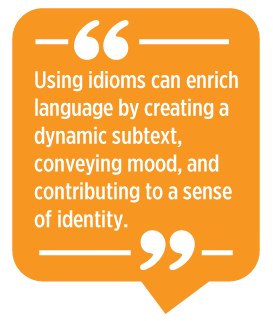
We’ve all seen textbooks with an “idioms list” either shoved in the back or relegated to a blurb in a single chapter. Figurative language is often undervalued and underutilized by English language teaching materials, contributing to the perception that idioms are unimportant. On the contrary, though, idioms are used for meaning-making throughout a wide variety of registers and genres. For this reason, teachers should raise students’ awareness of idioms and help them identify tools for unlocking their meaning. It is also essential for students to understand how using idioms can enrich language by creating a dynamic subtext, conveying mood, and contributing to a sense of identity.
Idioms are not rare. If you’re looking for it, you’ll realize that figurative language is extremely common in English, which means that idioms should not be taught in isolation. Like any other vocabulary item, idioms are used in specific contexts and for specific communicative purposes. Cooper (1999) has shown that learners are able to decode the majority of idioms they encounter by using three skills that we can explicitly teach:
- guessing from context
- using the literal meaning
- activating background knowledge
Teaching Specific Target Idioms
Because idioms exist in so many authentic contexts, you can teach them in conjunction with other language-learning tasks and goals. This approach makes it easier to fit idioms into a tight class schedule, and also helps students recognize that idioms are not a niche topic. Following are some example activities.
Sample Activity 1: Monopoly
Rationale
Playing games generates spontaneous language use. Board games with complicated written rules also require good reading skills, such as skimming, scanning, and syntax analysis. In other words, playing a board game can be a multiliteracy activity. Because the stakes are low and games are fun, they can also get shy students out of their shells.
Objectives
- Students will be able to (SWBAT) engage in friendly classroom competition.
- SWBAT ask clarifying questions, negotiate for meaning, and debate a guiding text.
- SWBAT use mortgage, rent, sell, and buy in context, and infer the meaning of two idioms.
Target Idioms
- Do not pass Go, do not collect $200
- Get-out-of-jail-free card
Lesson Procedure
-
Before class, have students read and annotate the rules of Monopoly.
-
In class, play a 90-minute game of Monopoly. You can assign students roles (banker, real estate agent, rule-reader) in advance to make this run smoothly. One student should record the audio while they play.
-
After class, have students listen to the audio recording of the game and analyze how they communicated during it.
-
Have them write a summary of how the game went.
-
Share short corpus examples of “do not pass go, do not collect $200” and “this is your get-out-of-jail-free card” being used outside the context of the game. From those examples and using the literal meanings from the game, have students infer potential figurative meanings for each.
Expansions
Many other idioms are derived from games, such as “cards on the table,” “call your bluff,” “cross off X on my card,” and “I’ll take [topic] for $200.” You can teach the basics of those games and share examples of those idioms to help students practice using literal meanings to infer figurative meanings.
Sample Activity 2: The Wizard of Oz (1939)

Rationale
Movies can teach a wide variety of listening skills, including analyzing dialect, register, and tone and understanding humor, sarcasm, and emotional intonation. In addition, many idioms were coined as references to plot points from famous movies. This activity involves watching the original scenes that coined those terms, and then inferring their idiomatic meanings from authentic contexts.
Main Objectives
- SWBAT draw connections between literal and figurative meanings.
- SWBAT work with authentic, corpus-based sample texts.
Target Idioms
- Not in Kansas anymore
- Ding dong, the witch is dead
- Off to see the wizard
- Flying monkeys
- Pay no attention to the man behind the curtain
Procedure
The class alternates between reading a synopsis of the movie The Wizard of Oz and watching key scenes with famous quotes. On the worksheet (provided in the Appendix), each quote is followed by a corpus example of it being used in an unrelated context. As the students work through the movie, they pause for small-group discussion of what each quote means a) in the movie and b) in the unrelated quote. Then, they extrapolate a context in which they could use that idiom themselves. You’ll be surprised how productive and creative these conversations become!
Expansions
The Wizard of Oz is a particularly rich source of famous quotes that are now used as idioms, but dozens of other movies and TV shows can be used in a similar way. Ask your students what kinds of movies they enjoy, and get creative!
Sample Activity 3: Alice in Wonderland
Rationale
Pleasure reading is a valuable tool in vocabulary acquisition. Alice in Wonderland is one of the most influential stories in the English language. Its influence on internet culture is most obvious in the increasing popularity of “down the rabbit hole.” Moreover, this children’s novel includes lots of wordplay and jokes, so the text is both accessible and challenging.
Main Objectives
- Assessing students’ reading level
- Raising awareness of cultural references
- SWBAT extrapolate a figurative meaning from the literal meaning of an idiom.
Target Idiom
- Down the rabbit hole
Procedure
-
Students read Chapter 1 of Alice in Wonderland (10 pages), in which Alice falls down a rabbit hole.
-
After they read, they must answer: “Now that you’ve read the chapter that created the idiom ‘[go] down the rabbit hole,’ what do you think that idiom means?” This forces them to use the literal meaning to extrapolate possible figurative meanings.
-
After sharing their best guesses, students check against definitions on theidioms.com.
-
Students look up the darker modern definition of “down the rabbit hole”: “To get extremely and obsessively involved in something.” Discuss how one meaning could lead to the other.
Expansions
Student enthusiasm sometimes justifies reading the rest of the novel together, which provides rich opportunities to work with descriptive language, wordplay, symbolism, characterization, and poetry. Students also sometimes know the drug-culture meaning of “down the rabbit hole,” which is “high.” For age-appropriate students, this provides an opportunity for you to add a listening text, “White Rabbit” by Jefferson Airplane.
Raising Awareness of Idioms, Identity, Styling, and Translanguaging
Personal speech style is composed of many different linguistic features. These styles can vary, shifting through communication strategies such as code-switching and translanguaging techniques. The following activities promote the use of idioms as identity-building and help foster diversity in speech through the “holistic and equitable view of multilingualism” (Wei, 2022).
Sample Activity 4: Personal Narrative
Rationale
The main purpose of a personal narrative is self-expression; it lends itself to a distinct authorial voice that can be amplified by idiomatic word choice.
Objectives
- Students will be exposed to a variety of personal narrative exemplar texts to identify different moods and personas.
- Students will learn idioms and compound adjectives to help build their vocabulary, specifically as they relate to character and setting.
- Students will gain an awareness of communication fluidity and practice flexing their multilingual repertoire through their own personal narrative piece.
Target Idioms
These can relate to personality, such as “cheapskate,” “big mouth,” and “go-getter,” or to intentions, such as “put one on a pedestal,” and “set an example.”
Procedure
-
Students read an excerpt from two different exemplar texts that are personal narratives, such as A House on Mango Street by Sandra Cisnero and 99 Nights in Logar by Jamil Jan Kochai. Here is a list of other texts related to “living between languages.”
-
Students discuss the texts and identify which idiomatic words and phrases convey personality/setting. Students also discuss why some words were not used in English.
-
Preteach common idioms that convey personality and setting (see target examples).
-
After class, have students write two different personal narratives about the same experience and try to convey two different moods based on their word choice using the vocabulary taught in class.
Expansions
Students review each other’s personal narratives and make guesses about word choice.
Sample Activity 5: Film Scripts
Rationale
Maintaining continuity, dialogue word choice shows personality. It is conducive to building idioms around a theme.
Objectives
- Students will examine how language conveys personality and how other linguistics features, such as rhythm and intonation, play into meaning.
- Students will have an awareness of how idioms are economical and relate to pop culture.
Target Idioms
Similar to the Personal Narrative exercise, you can review idioms that relate to personality or common exclamations, such “hitting the nail on the head.”
Procedure
-
Students read an excerpt from a movie script (scripts from Quentin Tarantino films tend to be rich with idioms, though these films should be screened for adult content and language).
-
Students identify the idioms and try to guess the meaning from context.
-
Students act out the script.
-
Read a character description of two different characters in a film (from the same script or a different one). Cut up a few lines of dialogue from two or three different characters. Have students match the dialogue to the correct character. Have students watch the scene and see if their guesses were correct.
Expansions
Have students brainstorm an “odd couple” (close friends with opposite personalities) for two of their characters and write dialogue. Students use idioms and are also encouraged to use idioms from their language.
Conclusion
Lessons on idioms should focus on developing strategies for students to notice, decode, and also use idioms. The activities in this article illustrate authentic contexts that expose students to idioms. Ultimately, students see how idioms can promote their identities, and they develop the confidence to add idioms to their own personal repertoires.
References
Cooper, T. C. (1999). Processing of idioms by L2 learners of English. TESOL Quarterly, 33(2), 233–262. https://doi.org/10.2307/3587719
Wei, L. (2022). Translanguaging as a political stance: Implications for English language education, ELT Journal, 76(2), 172–182. https://doi.org/10.1093/elt/ccab083
|
Download this article (PDF) |
Claire Fisher teaches in the Intensive English Program at Pratt Institute in Brooklyn, New York, USA. She is also their interim technology and assessment coordinator, and tutors both at Pratt and The New School. Previously, she has taught in community colleges, private language schools, and community-based organizations in New York, New Jersey, and Massachusetts. She also had the honor of appearing on Jeopardy! in its 36th season.
Meghan Killeen completed her MA in applied linguistics and literature at The University of Westminster in London, UK. Her research has focused on intersemiotics and multimodal teaching practices. She has taught at The ESL School of the New York Film Academy and is an instructor for The Intensive English Program at Pratt Institute. She is also the curriculum and assessment specialist for the Center for American Language and Culture (TCALC) at Temple University in Philadelphia.
| Next Article |
